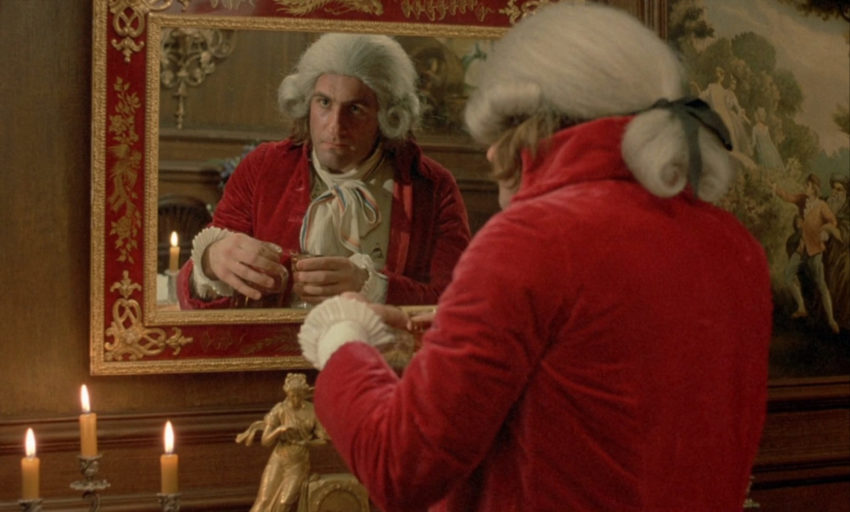
About half an hour into Danton, Andrzej Wajda’s 1983 film about the period of the French Revolution known as the Reign of Terror, the movie’s two main players finally come face to face. Georges Danton (Gérard Depardieu) has invited Maximilien Robespierre (Wojciech Pszoniak) to a private meeting over dinner. Danton, the latest target of Robespierre’s Committee of Public Safety, hopes to smooth things over with his one-time ally before Robespierre signs any arrest warrants. This tête-à-tête may be one of the film’s most famous scenes, and it’s one of my favorite parts of the movie. The scene deftly operates on multiple levels, suggesting the contours of the pair’s knotty personal relationship while simultaneously illuminating the stakes of their political disagreements.
In outlining the men’s political differences, the scene clearly sets out the central historical analogy that defined Danton’s reception upon release and has continued to guide twenty-first-century audiences’ understanding of the film. It’s not much of a stretch to understand Danton as a critique of the communist government that was still in power in Poland in the early 1980s. In this reading, the liberal Danton and his allies (played by French actors) stand in for the Polish Solidarity movement and democratic Western Europe more broadly; the authoritarian Robespierre and his Committee for Public Safety (played by Polish actors, with French dialogue dubbed in) correlate with the repressive communist regime that Solidarity resisted.* It’s nearly impossible to read anything about Danton without running into a discussion of how and why the film links these two points of political change and unrest across two centuries.
The dinner scene functions as a key to the film because it’s the scene that most legibly articulates the historical parallels the Polish director seems so eager to make. The scene fascinates me for the way that it exemplifies the film’s nuanced approach to presenting these connections. It’s here that I suppose I should admit that I’ve been a bit obsessed with Danton since I first watched it last month. As I struggled to figure out what, exactly, has so thoroughly captured my attention about this film, I kept returning to the proposed historical parallel at its center. I think I find Danton so compelling because I appreciate how Wajda draws parallels that actively destabilize certain historical narratives, which were themselves destabilizations of earlier historical narratives. By making what was at the time a somewhat subversive analogy, Wajda’s film obliquely asks the audience to consider the malleability of historical narrative.
The film’s script is based in part on Polish writer Stanisława Przybyszewska’s 1929 play, The Danton Case, which was significantly more admiring of Robespierre (whom the leftist playwright idolized and imagined as a proto-Marxist) and critical of Danton. Wajda’s adaptation takes the events described in the play but gives the material an ideological twist; the director’s formal choices align the audience with Danton. The dinner scene works as a potent example of how Wajda transforms an episode that shouldn’t, on its face, reflect well on Danton into an argument for the vital importance of Danton’s humanity.
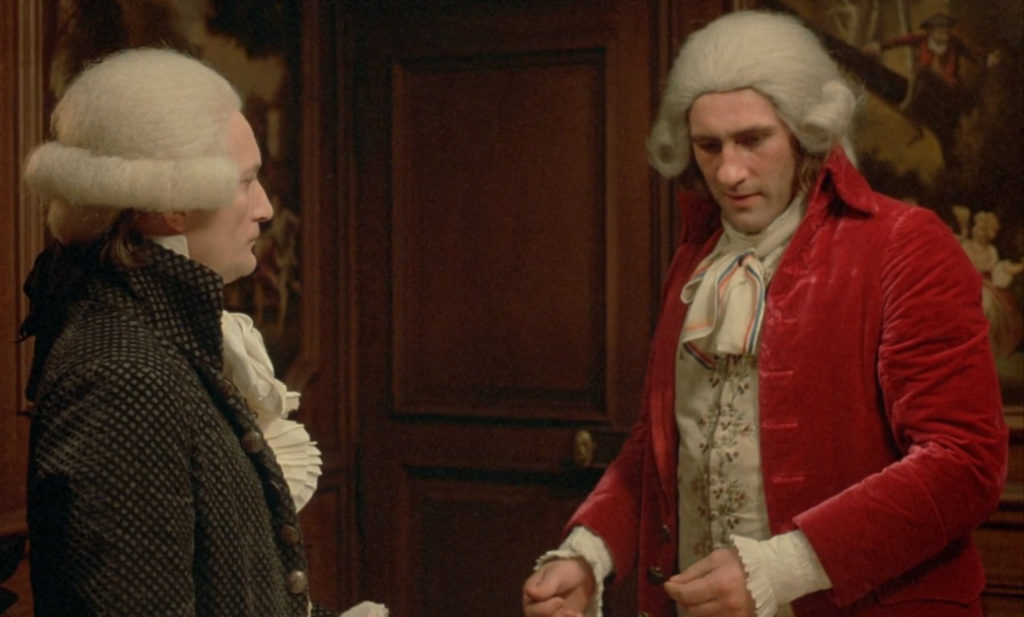
Depardieu and Pszoniak are, by all rights, co-leads in the film. Both actors receive roughly the same amount of screen time, and both actors give riveting performances.** One can imagine a version of Danton that treats Robespierre, rather than Danton, as the hero. In this version, Robespierre’s cool, detached fanaticism is a commendable commitment to principle, and Danton is a mess, too beholden to worldly concerns to uphold the pure values of the Revolution. And one can easily envision a rendition of the dinner scene, specifically, that is dismissive of Danton. In the scene as it is, both men are allowed room to state their positions openly and rather equally. Danton doesn’t outreason Robespierre and win the argument. In fact, the meeting ends when Danton drunkenly falls asleep on Robespierre’s chest. Danton is a bit of a mess here.
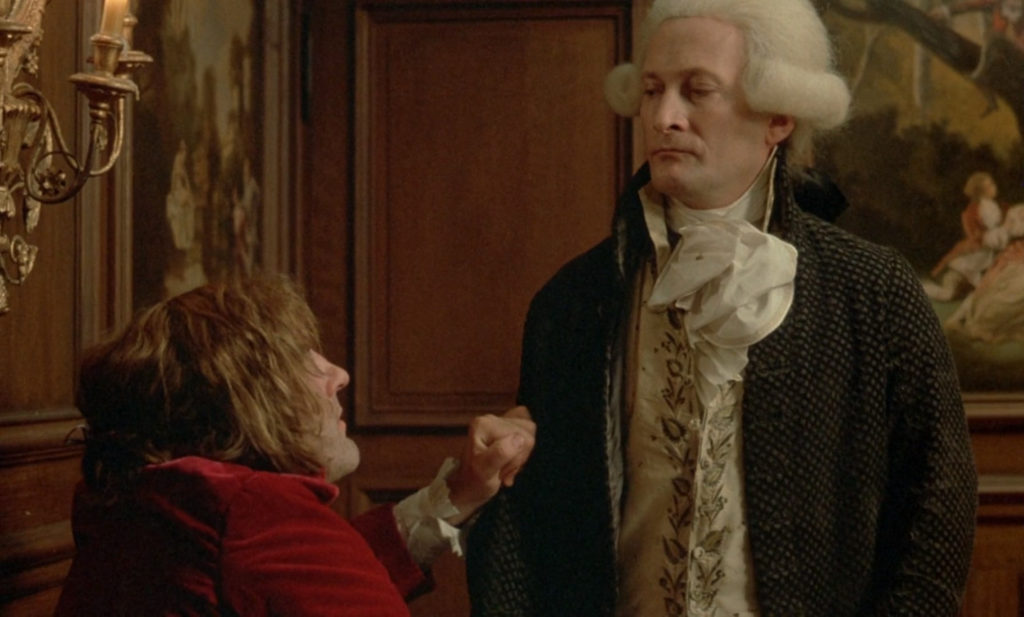
As embodied by Depardieu, however, Danton is such a glorious mess, and Wajda’s camera is in love with him. The scene begins with Danton as he prepares for the meeting before Robespierre shows up. Danton anxiously tastes all of the food, frets about the flowers, and compulsively fusses with his outfit. A sense of doom hangs over the proceedings from the start. Danton is plainly aware that his life hangs in the balance, that this meeting must go well if he’s to save his own head. Danton goes from giving directions in a hushed whisper to shouting at his companions at the drop of a hat. He’s nervous, and the camera never quite settles, fluidly following Danton as he bustles around readying the room for Robespierre.
As the minute of Robespierre’s arrival approaches, Danton suddenly has a moment of paranoia and demands that one of his associates forcibly remove everyone from the adjoining rooms in the hotel where he’s set the meeting.*** Danton’s man Bourdon violently and rudely clears the floor, disrupting a group of aristocratically-dressed people in one room who appear to be gambling, a private party of men watching a woman sensuously dance, and another gathering that looks to be a séance. The aristocrats get the worst manhandling, of course. The medium at the séance, however, gets an almost reverential treatment. Bourdon gently guides her out of her room, and she never seems to surface from her trance. She walks straight towards the camera, which is positioned just outside of the doorway, with her hands outstretched, humming. She turns into the hall at the last second, pitching her hum sharply upward, and the camera cuts back to Danton, inside the meeting room.
It’s a striking interlude that teases what Wajda mostly leaves out of the film. Bourdon’s rough manner acknowledges one of the major criticisms of Danton—that he and his cronies were thugs. Wajda sets up Danton and his opposition to the Terror as an analog for non-violent movements like Polish Solidarity, so he necessarily elides Danton’s involvement in violent actions earlier in the Revolution (like the insurrection of 1792 that led to the abolishment of the monarchy and the execution of Louis XVI). But Wajda does not totally sanitize Danton’s Cordeliers or change their character to make his argument. Instead, he makes Bourdon’s incivility more interesting to watch. Bourdon’s direct dealings with those in his way stands in stark contrast to the detachment of Robespierre’s Committee of Public Safety, whose members sign orders of execution regularly without ever getting their own hands dirty. None of the members of the Committee ever look as good on camera as Bourdon does after he gets the order from Danton to clear the adjoining rooms. He grins like a fox, then he saunters down the hallway, casually smoking, anticipating violence with the cool eagerness of a Hollywood gangster.
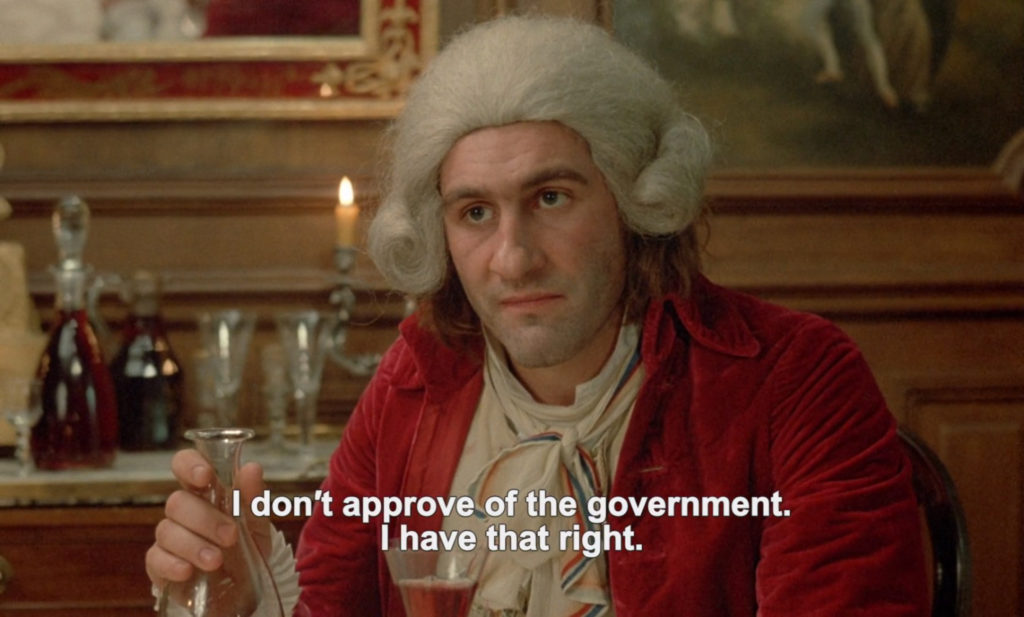
When we return to Danton, Robespierre is just entering the meeting room. As the meeting commences, the camera finally starts to come to a rest. The camera slowly follows Danton as the pair make their way from the doorway to the table. From the beginning, Robespierre is still while Danton continues to be a flurry of motion. He offers up various dishes and platters. He almost chokes after he tears into a quail breast to show Robespierre it isn’t poisoned. When Robespierre repeatedly refuses food, Danton dumps all of the dishes off the table and onto the floor. He compulsively pours himself glasses of wine. He gesticulates with his hands as he speaks. Danton stands up, looming over the still sitting Robespierre, and physically assaults his adversary. Danton switches seats. He takes off his wig and offers up his neck to Robespierre’s guillotine. Through all of this, Robespierre hardly moves. He’s coiled up, intense but tightly contained.
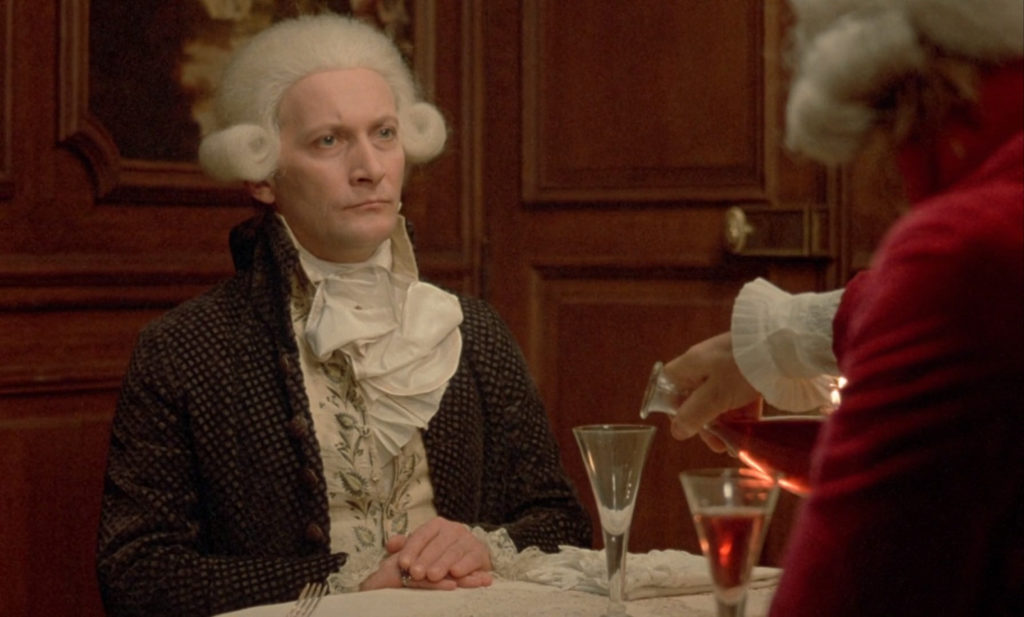
Wajda’s framing of Robespierre is also rather static. While the distance of the shots varies slightly, Robespierre is almost exclusively shown from the same perspective: a portrait-like three-quarters angle. When the camera moves to show a side view of the table, Robespierre’s severe profile takes over the foreground while Danton carries on behind him. Robespierre’s almost inhuman immobility and composure stands out all the more in comparison to Danton’s restlessness.
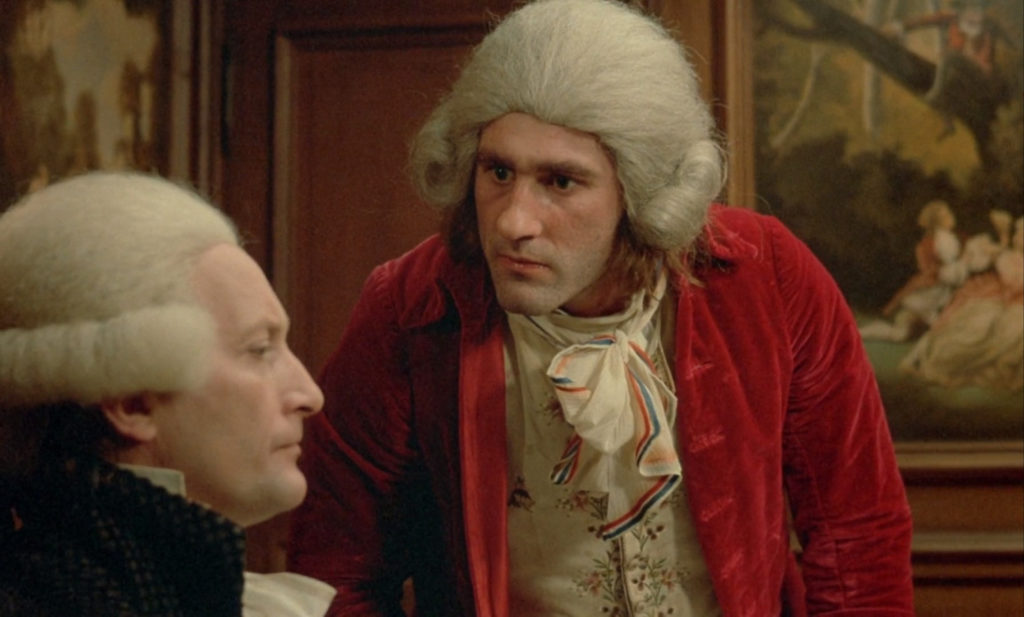
When Danton moves, the camera follows him, but, for the most part, the camera stays still. The two men’s conversation is mostly composed of over-the-shoulder shots, switching between each man as he speaks. While Robespierre is framed very similarly in each of these shots, Wajda frames Danton in as many different ways as possible in the confined space. Danton can’t be defined by one type of shot; the camera must consider him from all different angles. Depardieu’s performance is the opposite of contained. Danton’s energy threatens to overflow the frame, and the camera constantly adjusts to try to capture it.
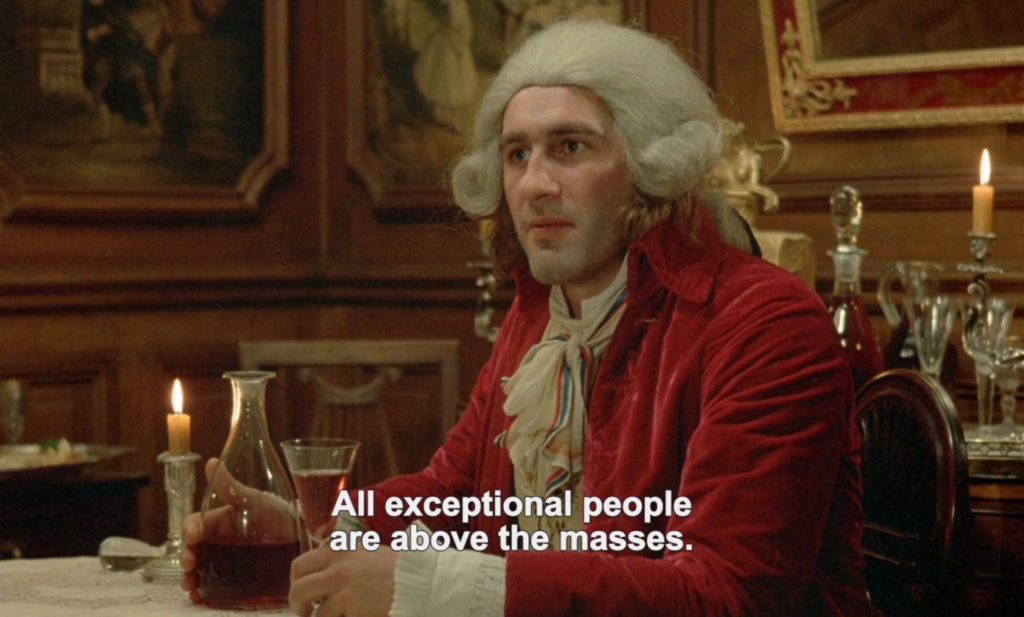
Danton’s argument in this scene boils down to a defense of individuality and praise of exceptional men. Danton accuses Robespierre of “chop[ping] off any head above the rest” and asserts that “all exceptional men are above the masses.” Wajda’s camera treats Danton as an exceptional individual, captivating in all of his unruliness and folly. (And drunkenness.) “You want men to act like the heroes of novels,” Danton admonishes Robespierre. “You forget we’re made of flesh and blood.” Robespierre might act more dignified in this instance, and he is even, perhaps, more articulate in defending his course of political action. But Danton is more relatable.
Relatability is a key factor at work when formulating a historical parallel. History educators in a variety of contexts are enamored of the idea that if they can come up with the right example, then history will “come alive” for the people learning about it in the here and now. Frankly, it’s simply good pedagogical practice to assume that people aren’t interested in learning anything unless it relates to their lives directly. The majority of historical parallels make the past more knowable by making it more familiar—more relatable.
When historical parallels are used to make us comfortable with what’s happening in the present, however, we get into the territory of myth-making. This happened with the French Revolution, particularly in France, but also in other European countries that undertook their own revolutionary actions in later decades and centuries. The French Revolution became an inspiration and a model, a warning and a failure. As each new generation sought to position the French Revolution to suit their own ends, the history underwent reinterpretation. Both Robespierre and Danton only rose in historical estimation in the later part of the nineteenth century, as various political factions reevaluated the legacy of the French Revolution and found new heroes to support their own agendas.
Robespierre’s reputation, in particular, was massively rehabilitated with the emergence of leftist, working-class political movements in the latter half of the nineteenth century. The eighteenth-century Jacobin’s commitment to principles of egalitarianism became a historical precedent for the kind of socialist thought that was gaining currency. As Robespierre’s intellectual contributions were rediscovered and newly appreciated by the European left, his status as the premiere “villain” of the French Revolution shifted. The Danton Case, the play on which Danton is partially based, is a product of this shift.
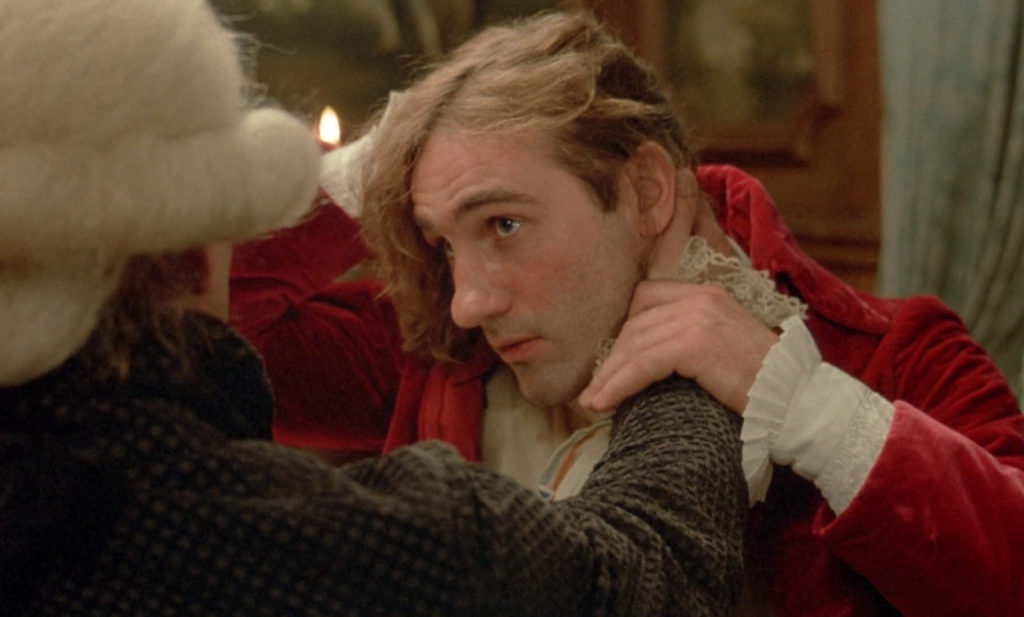
So Wajda took what was a popular historical parallel in leftist circles—a parallel that was used to give leftist governments an acceptable, Enlightenment-era intellectual heritage—and flipped it to make it uncomfortable. I find Danton so intriguing not because of the historical parallel it makes but because of how it makes that parallel. Danton and Robespierre used to be friends and allies, and their trajectories in the Revolution only diverged at the very end. Wajda understands that only a slight adjustment needs to be made to mount the case against Robespierre—who, it should be noted, is not necessarily vilified in the film. Danton is a variation on a theme, not a rewriting of the story. The dinner scene expertly illustrates Wajda’s approach. On some level, I think the film is designed to force the audience to think about historical parallels and how they work to reinforce national and political identities. It’s all about the framing, quite literally.
*Wajda denied on record that he was trying to make any such pointed connections, but these denials only came after the socialist French government (which had partially financed the film) reacted badly to the film’s perceived anti-leftist attitude. Robert Darton’s essay “Danton and Double Entendre” provides the definitive overview of the reasons for the film’s cool reception in France at the time of its release. See: Robert Darnton, “Danton and Double Entendre.” The Kiss of Lamourette (New York: W.W. Norton, 1990).
**This is all the more remarkable in Pszoniak’s case, since, as previously mentioned, his dialogue is dubbed in by a French actor.
***I’m not sure what, exactly, to call the place where Danton and Robespierre meet. Their room is private, but the building is not. I’ve seen the location referred to as a “hotel” in other pieces about the film, so that’s what I’m going with. If any historians who specialize in eighteenth-century France are reading this, please correct me if you know a better or more accurate term.
POST SCRIPT: If you are interested in fiction about the Reign of Terror, I would highly recommend Hilary Mantel’s A Place of Greater Safety. Mantel’s novel follows Danton, Robespierre, and Desmoulins from cradle to guillotine; and the book gorgeously evokes the atmosphere of the French Revolution through its many twists and turns. The events covered at the end of A Place of Greater Safety and the events of Danton overlap, but the characterizations of each main player differ significantly enough to make the film and the novel quite interesting to compare.